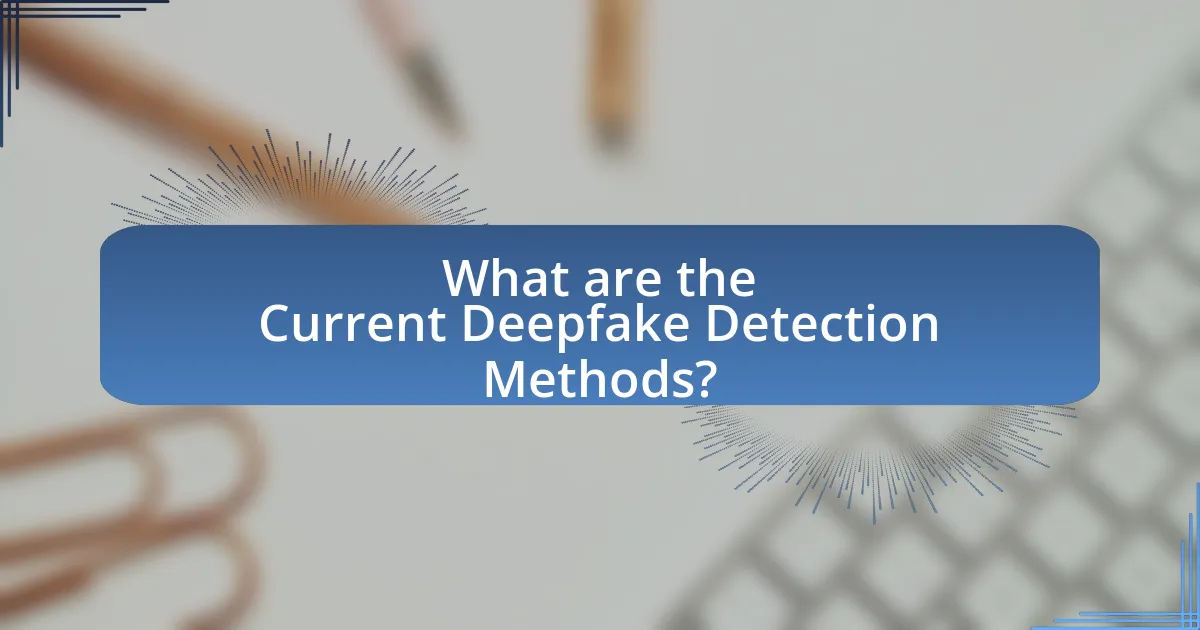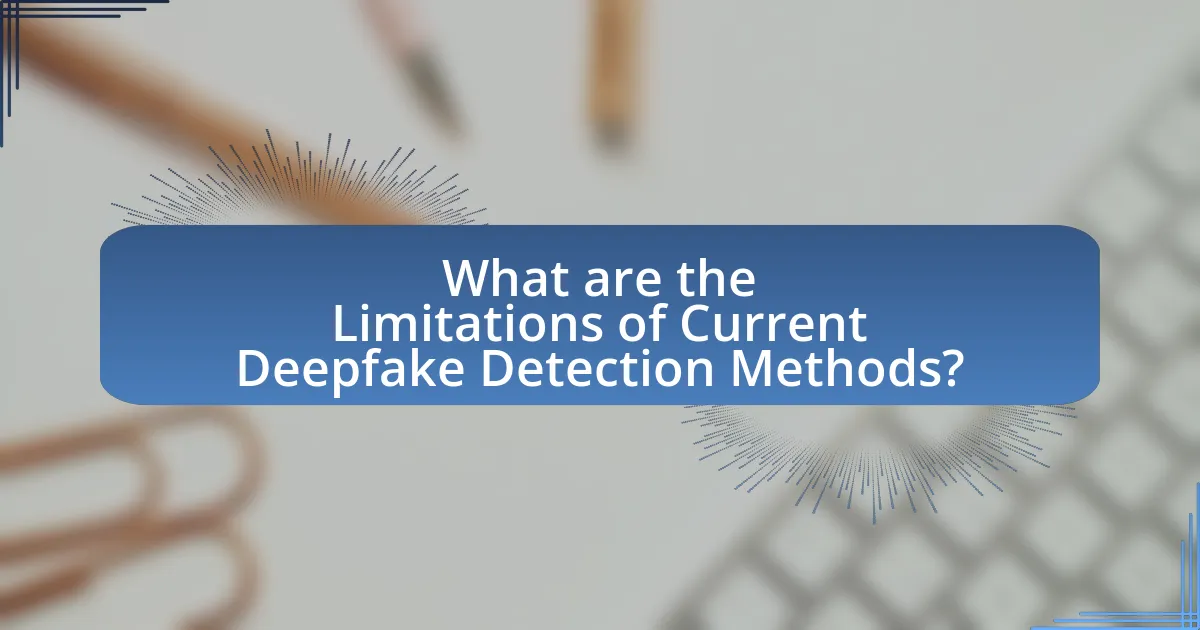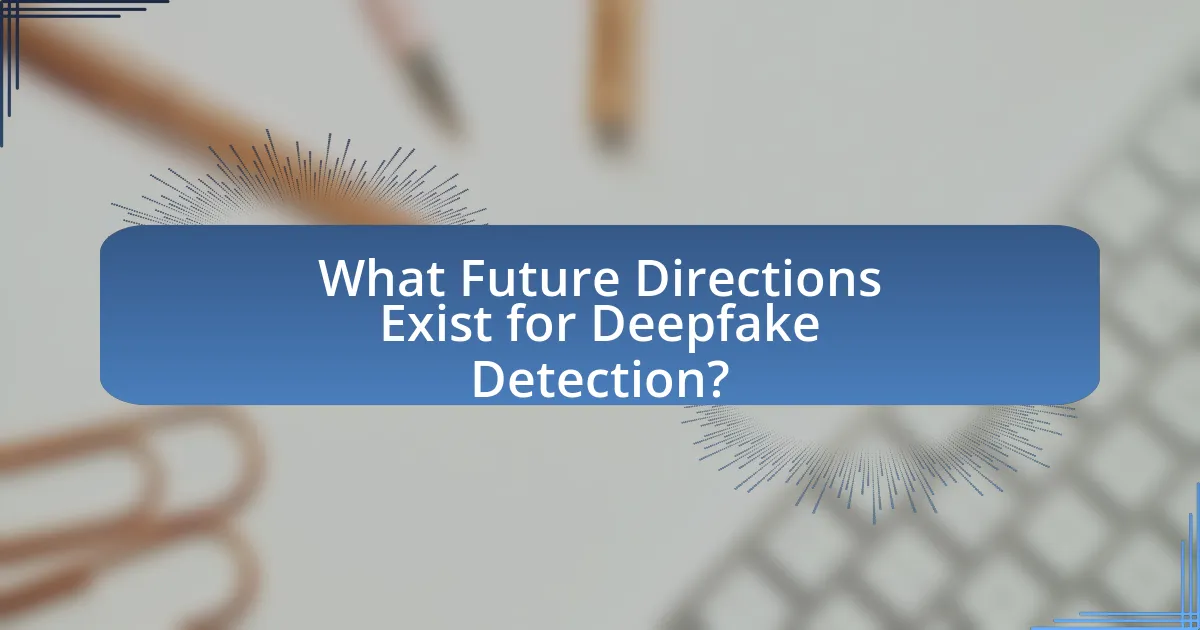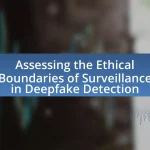The article focuses on the limitations of current deepfake detection methods, highlighting the challenges posed by the rapid advancement of deepfake technology. It examines various detection techniques, including machine learning algorithms, visual artifacts analysis, and biometric recognition, and discusses their effectiveness in identifying manipulated media. The article also addresses the accuracy of these methods, the factors contributing to false positives and negatives, and the implications of detection limitations on public trust and misinformation. Furthermore, it explores future directions for improving detection technologies and strategies to mitigate risks associated with deepfakes.

What are the Current Deepfake Detection Methods?
Current deepfake detection methods include machine learning algorithms, visual artifacts analysis, and biometric recognition techniques. Machine learning algorithms, such as convolutional neural networks (CNNs), are trained on large datasets of real and fake videos to identify inconsistencies in facial movements and expressions. Visual artifacts analysis focuses on detecting anomalies in pixel-level details, such as unnatural lighting or irregularities in skin texture. Biometric recognition techniques assess physiological traits, like eye blinking patterns or voice modulation, which are often altered in deepfakes. Research has shown that these methods can achieve varying degrees of accuracy, with some studies reporting detection rates exceeding 90% under controlled conditions.
How do these methods identify deepfakes?
Methods identify deepfakes by analyzing inconsistencies in visual and audio data that deviate from authentic content. These techniques utilize machine learning algorithms to detect artifacts, such as unnatural facial movements, irregular blinking patterns, and mismatched audio-visual synchronization. For instance, convolutional neural networks (CNNs) are trained on large datasets of real and fake videos, enabling them to recognize subtle discrepancies that human observers might miss. Research has shown that these algorithms can achieve high accuracy rates, often exceeding 90% in controlled environments, thereby validating their effectiveness in distinguishing deepfakes from genuine media.
What technologies are utilized in deepfake detection?
Deepfake detection utilizes technologies such as machine learning algorithms, computer vision techniques, and digital forensics. Machine learning algorithms, particularly convolutional neural networks (CNNs), analyze patterns in video and audio data to identify inconsistencies that indicate manipulation. Computer vision techniques focus on detecting artifacts and anomalies in facial movements and expressions that are characteristic of deepfakes. Digital forensics tools examine metadata and file structures to uncover signs of tampering. These technologies have been validated through various studies, including research published in the IEEE Transactions on Information Forensics and Security, which demonstrates their effectiveness in distinguishing between real and manipulated media.
How effective are these technologies in real-world scenarios?
Current deepfake detection technologies are moderately effective in real-world scenarios, with varying success rates depending on the specific methods employed. For instance, studies have shown that traditional detection techniques can achieve accuracy rates of around 65% to 90% in controlled environments, but their effectiveness diminishes significantly when faced with high-quality deepfakes or real-time applications. Research published in the IEEE Transactions on Information Forensics and Security indicates that adversarial attacks can reduce detection accuracy by up to 30%, highlighting the ongoing challenges in adapting these technologies to dynamic and evolving deepfake content.
What challenges do current methods face?
Current methods for deepfake detection face significant challenges, primarily due to the rapid advancement of deepfake technology, which often outpaces detection capabilities. These methods struggle with high variability in deepfake generation techniques, leading to inconsistencies in detection accuracy. For instance, a study published in 2020 by Korshunov and Marcel demonstrated that state-of-the-art detection systems could achieve only about 65% accuracy against advanced deepfakes, indicating a substantial gap in effectiveness. Additionally, current methods often rely on specific features that can be easily manipulated by creators of deepfakes, further complicating the detection process.
Why is it difficult to detect high-quality deepfakes?
High-quality deepfakes are difficult to detect due to their advanced use of artificial intelligence techniques that create highly realistic images and videos. These deepfakes often employ generative adversarial networks (GANs), which can produce synthetic media that closely mimics the nuances of human expressions, movements, and voice, making it challenging for detection algorithms to identify inconsistencies. Research indicates that traditional detection methods struggle against these sophisticated models, as they rely on identifying artifacts or anomalies that may not be present in high-quality deepfakes. For instance, a study published in 2020 by Korshunov and Marcel demonstrated that state-of-the-art detection systems had significantly reduced accuracy when tested against high-quality deepfakes, highlighting the limitations of current detection technologies.
How do evolving deepfake techniques impact detection methods?
Evolving deepfake techniques significantly challenge detection methods by continuously improving the realism and sophistication of manipulated content. As deepfake algorithms advance, they create more convincing audio and visual fakes, making it increasingly difficult for traditional detection tools to identify discrepancies. For instance, research from the University of California, Berkeley, highlights that state-of-the-art deepfake generation models, such as those using generative adversarial networks (GANs), can produce outputs that are indistinguishable from real media, thereby outpacing existing detection algorithms. Consequently, detection methods must evolve concurrently, incorporating machine learning advancements and developing new techniques to analyze subtle artifacts that may indicate manipulation.

What are the Limitations of Current Deepfake Detection Methods?
Current deepfake detection methods face significant limitations, primarily due to their reliance on specific algorithms that may not generalize well across diverse deepfake techniques. These methods often struggle with the rapid evolution of deepfake technology, as new generation techniques can bypass existing detection systems. For instance, a study by Korshunov and Marcel (2018) demonstrated that deepfakes generated with advanced techniques could evade detection by traditional methods, highlighting the arms race between deepfake creation and detection. Additionally, many detection systems require large datasets for training, which may not be available for all types of deepfakes, leading to reduced accuracy in real-world applications. Furthermore, the effectiveness of these methods can be compromised by variations in video quality, lighting, and resolution, making it challenging to maintain consistent detection performance across different scenarios.
How accurate are current detection methods?
Current detection methods for deepfakes exhibit varying levels of accuracy, typically ranging from 60% to 90%. Research conducted by the University of California, Berkeley, and published in the journal “Nature” indicates that while some algorithms can effectively identify manipulated media, they often struggle with high-quality deepfakes that utilize advanced techniques. For instance, the study found that state-of-the-art models achieved around 86% accuracy on certain datasets, but this performance dropped significantly when faced with more sophisticated deepfake generation methods. Thus, while detection methods are improving, their accuracy is not universally reliable and is heavily dependent on the quality and type of deepfake being analyzed.
What factors contribute to false positives and negatives?
False positives and negatives in deepfake detection are primarily influenced by the quality of the training data, the sophistication of the deepfake technology, and the algorithms used for detection. High-quality training data that includes a diverse range of real and fake examples can improve detection accuracy, while poor-quality data can lead to misclassifications. Sophisticated deepfake techniques, which can mimic real human features and behaviors closely, increase the likelihood of false negatives, as detection algorithms may struggle to identify subtle manipulations. Additionally, the algorithms themselves can introduce biases; for instance, if they are not adequately trained on specific types of deepfakes, they may incorrectly classify them, resulting in false positives. Studies have shown that detection systems can achieve varying levels of accuracy based on these factors, highlighting the challenges in reliably identifying deepfakes.
How does the quality of the deepfake affect detection accuracy?
The quality of a deepfake significantly impacts detection accuracy, as higher-quality deepfakes are more challenging to identify. Research indicates that deepfakes with realistic facial movements, expressions, and audio synchronization can evade detection tools, which often rely on inconsistencies or artifacts. For instance, a study by Korshunov and Marcel (2018) demonstrated that state-of-the-art detection methods achieved only 65% accuracy against high-quality deepfakes, compared to over 90% accuracy for lower-quality versions. This illustrates that as the quality of deepfakes improves, the effectiveness of current detection methods diminishes, highlighting a critical limitation in combating deepfake technology.
What are the implications of these limitations?
The implications of the limitations in current deepfake detection methods include increased risks of misinformation and erosion of trust in digital media. These limitations hinder the ability to accurately identify manipulated content, allowing harmful deepfakes to proliferate, which can mislead the public and influence opinions or behaviors. For instance, a study by Kietzmann et al. (2020) highlights that as detection methods lag behind the sophistication of deepfake technology, the potential for malicious use in political campaigns or social manipulation escalates, undermining democratic processes and societal trust.
How do limitations affect trust in media?
Limitations in media, particularly regarding deepfake detection methods, significantly undermine public trust. When detection technologies fail to accurately identify manipulated content, audiences may become skeptical of the authenticity of all media, leading to a generalized distrust. For instance, a study by the Stanford University researchers found that as deepfake technology improves, the perceived credibility of video content declines, with 70% of participants expressing doubt about the authenticity of videos they encounter online. This erosion of trust can result in individuals questioning legitimate news sources and becoming more susceptible to misinformation, ultimately impacting societal discourse and democratic processes.
What are the potential consequences for individuals and society?
The potential consequences for individuals and society regarding the limitations of current deepfake detection methods include increased misinformation, erosion of trust in media, and potential harm to personal reputations. Individuals may fall victim to manipulated content, leading to misinformed decisions or reputational damage, as evidenced by cases where deepfakes have been used to create false narratives about public figures. Society faces broader implications, such as the undermining of democratic processes, as deepfakes can be weaponized to influence elections or public opinion, demonstrated by instances during the 2020 U.S. elections where misinformation spread rapidly online. The inability to effectively detect deepfakes exacerbates these issues, highlighting the urgent need for improved detection technologies to safeguard both individuals and societal integrity.

What Future Directions Exist for Deepfake Detection?
Future directions for deepfake detection include the development of more sophisticated machine learning algorithms, enhanced feature extraction techniques, and the integration of multi-modal data sources. Researchers are focusing on improving the accuracy of detection systems by utilizing advanced neural networks that can better identify subtle artifacts in deepfake videos. For instance, studies have shown that combining visual, audio, and contextual cues can significantly enhance detection capabilities. Additionally, ongoing research emphasizes the importance of real-time detection systems that can operate effectively across various platforms and formats, addressing the rapid evolution of deepfake technology.
How can current methods be improved?
Current methods for deepfake detection can be improved by integrating advanced machine learning algorithms that utilize multi-modal data analysis. By combining visual, auditory, and contextual cues, these algorithms can enhance the accuracy of detection. Research indicates that models employing ensemble learning techniques, which aggregate predictions from multiple algorithms, can significantly reduce false positives and negatives. For instance, a study published in the IEEE Transactions on Information Forensics and Security demonstrated that a hybrid approach using convolutional neural networks alongside recurrent neural networks improved detection rates by over 15% compared to traditional methods. This evidence supports the assertion that leveraging diverse data sources and sophisticated algorithmic strategies can lead to more robust deepfake detection systems.
What role does machine learning play in enhancing detection?
Machine learning significantly enhances detection by enabling systems to identify patterns and anomalies in data that are often imperceptible to human analysts. In the context of deepfake detection, machine learning algorithms can analyze vast datasets of authentic and manipulated media to learn distinguishing features, improving accuracy in identifying deepfakes. For instance, a study published in 2020 demonstrated that convolutional neural networks (CNNs) could achieve over 90% accuracy in detecting deepfakes by learning from thousands of examples, showcasing the effectiveness of machine learning in this domain.
How can collaboration among researchers improve outcomes?
Collaboration among researchers can improve outcomes by facilitating the sharing of diverse expertise and resources, leading to more comprehensive solutions. When researchers from different fields work together, they can combine their knowledge to address complex problems, such as the limitations of current deepfake detection methods. For instance, interdisciplinary collaboration can integrate insights from computer science, psychology, and ethics, enhancing the development of more robust detection algorithms. Studies have shown that collaborative research often results in higher-quality publications and innovative breakthroughs, as evidenced by a 2018 analysis published in the journal “Nature,” which found that collaborative papers received more citations than those authored by individuals. This indicates that collaboration not only enriches the research process but also significantly enhances the impact and effectiveness of the outcomes.
What best practices can be adopted for effective detection?
To achieve effective detection of deepfakes, implementing a multi-faceted approach is essential. This includes utilizing advanced machine learning algorithms that are specifically trained on diverse datasets of both real and manipulated media, which enhances the model’s ability to identify subtle inconsistencies. Additionally, incorporating real-time analysis tools can significantly improve detection rates, as they allow for immediate assessment of content as it is being consumed. Research indicates that combining multiple detection techniques, such as visual artifacts analysis and audio-visual coherence checks, leads to higher accuracy in identifying deepfakes. For instance, a study published in the IEEE Transactions on Information Forensics and Security demonstrated that models employing ensemble methods outperformed single-method approaches by up to 15% in detection accuracy.
How can individuals and organizations stay informed about deepfake technology?
Individuals and organizations can stay informed about deepfake technology by regularly following reputable sources such as academic journals, technology news websites, and industry reports. For instance, publications like the Journal of Digital Forensics, Security and Law and platforms like MIT Technology Review provide insights into the latest developments and research in deepfake technology. Additionally, attending conferences and webinars focused on artificial intelligence and cybersecurity can enhance understanding of the evolving landscape of deepfakes. Engaging with online communities and forums dedicated to AI ethics and digital media can also facilitate knowledge sharing and updates on detection methods and implications.
What strategies can be implemented to mitigate risks associated with deepfakes?
To mitigate risks associated with deepfakes, organizations can implement a combination of technological solutions, regulatory measures, and public awareness campaigns. Technological solutions include the development of advanced detection algorithms that utilize machine learning to identify inconsistencies in deepfake content, as evidenced by research from the University of California, Berkeley, which highlights the effectiveness of AI in distinguishing manipulated media. Regulatory measures can involve creating legal frameworks that penalize the malicious use of deepfakes, as seen in laws enacted in various jurisdictions that address the misuse of synthetic media. Public awareness campaigns educate individuals about the existence and potential dangers of deepfakes, empowering them to critically evaluate the authenticity of media they encounter. These strategies collectively enhance resilience against the threats posed by deepfakes.


